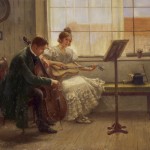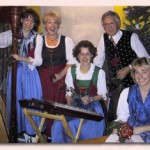By Cecilia Cloughly
 From time immemorial, there have been musicians and shamans who brought some form of music to all societies around the world. One can imagine hunters chanting the successes of the hunt around a bonfire as well as women singing to pass the time as they worked. We all wonder about the poet (or poets) of the Iliad and Odyssey.
From time immemorial, there have been musicians and shamans who brought some form of music to all societies around the world. One can imagine hunters chanting the successes of the hunt around a bonfire as well as women singing to pass the time as they worked. We all wonder about the poet (or poets) of the Iliad and Odyssey.
Around 1207, the Wartburg, the seat of the Thuringian landgraves until 1440, became the venue of the Sängerkrieg, the Minstrels’ Contest, in which such Minnesänger as Walther von der Vogelweide and Wolfram von Eschenbach participated.
Likewise, through the centuries European courts welcomed wandering musicians to the tables of the nobility. And while sons were trained in knightly skills, daughters were taught to sing and play an instrument, as well as to sew.
Beginning in the 16thth century and the growth of lower nobility, the wealthy merchant classes, and courts of church leaders, a system of sponsorship for gifted musicians such as Monteverdi, Vivaldi, Haydn, and Mozart developed.
As the life of the middle classes improved, it became the practice of many families to teach the children to play instruments and to sing. Hausmusik became a very important part of family life. Children learned piano, guitar, accordion, recorders, zithers, and rhythm instruments. People sang folk songs and religious music at home, in the schools, and at local groups. They formed a Gesangsverein and choirs like the Wiener Sängerknaben. The story about the Austrian “Familie Trapp” immortalized by the all-time hit “The Sound of Music” is a good example of the practice of Hausmusik.
 Even today, music is still an important part of the school curriculum in Germany and Austria.
Even today, music is still an important part of the school curriculum in Germany and Austria.
Unfortunately, in the U.S. today, fewer children are learning instruments. The number of American classical music lovers is dwindling, and many orchestras are going bankrupt. Difficult economic times have accelerated the decrease in music in the States.
Do You Have an Unused Music Instrument at Home? Give it a Second Life!
A life-long avid French hornist, Cecilia has started a long-term community service activity through the Claremont (CA) Symphony Orchestra to help struggling public school music programs. She is developing a network of retired music educators and repairers who volunteer to refurbish the instruments and hopes to get donations from all over the U.S. Target schools include the five-year-old Pomona Charter School for the Arts and Enterprise, which teaches no orchestral instruments and has no instruments at all to lend to its needy high school students.
*********************************************************************
The Claremont (CA) Symphony “Music Man” Project
Recycling Donated Instruments to Schools
YOU
* Donate a music instrument of any kind in any condition
THE CSO VOLUNTEERS
* Pick it up or refund your shipping costs.
* Give you a receipt for the IRS. (You enter the amount of value.)
* Clean and/or repair your instrument.
* Donate your refurbished instrument to multiple school districts.
501(c)(3) non-profit organization established in 1953. www.ClaremontSO.org
If you have an instrument to donate, please contact us at claremont.symphony.orchestra@gmail.com
———————————————————————————————————————————————-